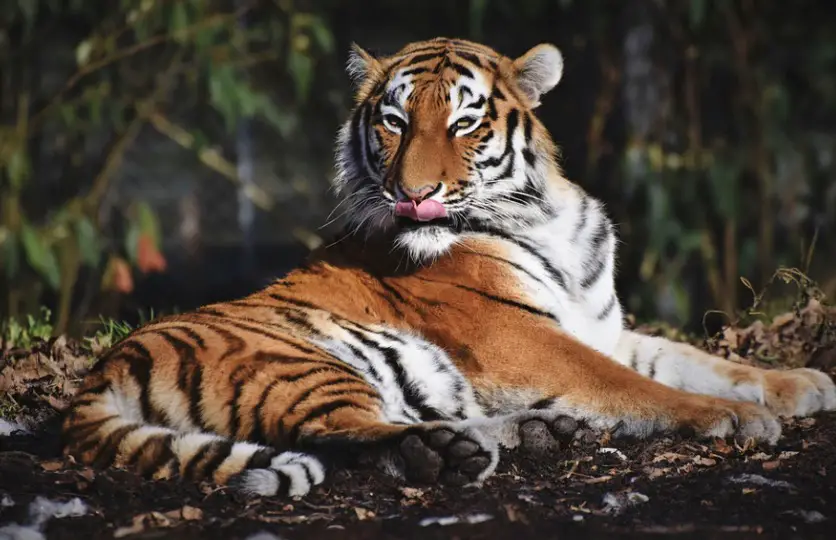Table of Contents
Siberian Tiger: All You Need To Know
A Siberian tiger is an apex predator which belongs to the kingdom of Animalia, phylum Chordata, and class Mammalia. Its genus is Panthera and its species is P. t. tigris. Its length is 150 cm, and it weighs about 100 to 306 kg. It lives in the mountainous forests, with a lifespan of 16 to 18 years.

Siberian Tiger Description
The Siberian tiger (Panthera tigris tigris) is a subspecies of the tiger (P. tigris) that is found in far eastern Russia, China, and North Korea. It has the most genetic resemblance to the extinct Caspian tiger of Central and Western Asia.
Their thick, coarse fur is a red-rust or rust-yellow hue, with distinctive transverse stripes along the length of their bodies. Compared to other tiger species, their ground coat is frequently light, and it varies according to seasons and populations. It has a long tail and an elongated torso with short, powerful legs.
Siberian tigers may grow up to 60 inches (150 cm) in length and weigh up to 675 pounds (306 kg). Larger tigers were traditionally hunted, and most living tigers fall short of this, with females weighing at least 220 pounds (100 kg).

Tigers are often solitary creatures. They scent-mark huge regions in order to claim them as part of their territory. They’ll guard this region fiercely and pursue any prey that wanders within it. Large mammals like deer and boar, as well as the offspring of even larger species, may fall into this category. When smaller creatures such as rabbits and badgers are available, they will devour them. They use their stealth and camouflage to ambush their prey after trailing it down.

Female tigers generally give birth to litters of two to six cubs after a three-month pregnancy, which they rear with little help from male tigers. Cubs can’t hunt until they’re at least 18 months old, and they’ll stay with their moms for two to three years before venturing out on their own. Female tigers may accept their female cubs sharing part of their territory as adults in some situations.
Siberian Tiger: Current and Historic Range
Siberian tigers used to roam over the Korean Peninsula, as well as northern China and Mongolia. In fact, depending on where it was seen, it was variously known as the “Amur tiger,” “Manchurian tiger,” “Korean tiger,” and “Ussurian tiger.” The surviving population lives in a hilly region of Russia’s Primorye Province, which is part of Siberia, thus the name “Siberian tiger.”
Only 350 Siberian tigers survived in the wild in 2005. Populations have remained stable, even increasing to around 550 individuals in 2014, thanks to intensive conservation efforts. However, habitat degradation and illegal poaching continue to pose a threat to their survival, and the IUCN continues to designate them as “Endangered.”

Fun Facts About Siberian Tiger!
Tigers are among the most well-known animals on the planet. They’re mysterious, elusive, gorgeous, and dangerous all at the same time. Despite this, three tiger subspecies became extinct in the twentieth century, and more are on the verge of doing so. Clearly, despite our collective knowledge of their remarkable nature and capacity to captivate our imaginations, we are failing to keep them safe.
Siberian Tiger: The Great Traveler
According to the findings of DNA research, Caspian and Siberian tigers have a single ancestor who migrated from Eastern China via the Gansu-Silk Road corridor, conquering Central Asia and eventually crossing Siberia. Modern Siberian tigers have been known to travel long distances.
Despite the fact that their range has been reduced, it appears that they will make the most of it, going up to 1000 kilometres in pursuit of prey or mates. Siberian tigers have been known to walk up to 60 kilometres every day, according to some reports. With this in mind, it’s easy to see why tiger conservation is so reliant on the preservation of huge swaths of undeveloped land.
Rare Neighbors
This area is home to another unusual big feline. Tigers, on average, spend less time at higher elevations than leopards. However, in the Changbai Mountains, the Amur leopard’s habitat overlaps with that of Siberian tigers. This, along with Siberian tigers, is one of the world’s most elusive big cats. The IUCN has classified it as critically endangered.
Siberian Tiger: Not a Man-eater
Tigers, despite their reputation as a terrible menace, are extremely elusive and seek to avoid humans at all costs. When tigers grow hostile toward humans, it is typically because they are unwell or wounded and so unable to hunt effectively. Individual tigers are occasionally driven to such behaviour by decreasing prey species populations.
This norm, however, has several interesting and scary exceptions. John Vaillant tells the story of Vladimir Markov, a poacher in Far East Russia, in his novel “The Tiger.” Before grabbing a portion of the tiger’s prey, he shot and injured it. The injured tiger pursued the hunter, trashed his hut, and then awaited his return before killing and devouring him. This unusual case seems to show the tiger waiting up to two days for the hunter before killing him in a vengeful deed.
Although there are groups of tigers in India that murder humans on a regular basis, this is believed to be extremely unusual behaviour. People have retaliated by murdering tigers, thus increasing the threat to tiger numbers.
Siberian Tiger Citations
- Spotting the elusive Siberian tiger: Complete response to ibrutinib in a patient with Waldenström Macroglobulinemia. Am J Hematol . 2018 May 14.
- Isolation and identification of tiger parvovirus in captive siberian tigers and phylogenetic analysis of VP2 gene. Infect Genet Evol . 2019 Nov;75:103957.
- Endoparasites of the Siberian tiger (Panthera tigris altaica). Integr Zool . 2018 Sep;13(5):507-516.







